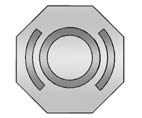Chevrolet Sonic Owner's Manual: Brake Fluid

The brake/clutch master cylinder reservoir is filled with DOT 3 brake fluid as indicated on the reservoir cap. See Engine Compartment Overview for the location of the reservoir.
There are only two reasons why the fluid level in the reservoir might go down:
- The fluid level goes down because of normal brake lining wear. When new linings are installed, the fluid level goes back up.
- A fluid leak in the brake/clutch hydraulic system can also cause a low fluid level. Have the brake/ clutch hydraulic system fixed, since a leak means that sooner or later the brakes and/or clutch will not work well.
Do not top off the brake/clutch fluid. Adding fluid does not correct a leak. If fluid is added when the linings are worn, there will be too much fluid when new brake linings are installed. Add or remove brake fluid, as necessary, only when work is done on the brake/clutch hydraulic system.
Warning
If too much brake fluid is added, it can spill on the engine and burn, if the engine is hot enough. You or others could be burned, and the vehicle could be damaged. Add brake fluid only when work is done on the brake/clutch hydraulic system.
When the brake/clutch fluid falls to a low level, the brake warning light comes on. See Brake System Warning Light.
 Replacing Brake System Parts
Replacing Brake System Parts
The braking system on a vehicle is complex. Its many parts have to be of top
quality and work well together if the vehicle is to have really good braking. The
vehicle was designed and tested with ...
 What to Add
What to Add
Use only new DOT 3 brake fluid from a sealed container. See Recommended Fluids
and Lubricants.
Always clean the brake/clutch fluid reservoir cap and the area around the cap
before removing it. Th ...
Other materials:
GM Mobility Reimbursement Program
This program is available to qualified applicants for cost reimbursement of eligible
aftermarket adaptive equipment required for the vehicle, such as hand controls or
a wheelchair/ scooter lift for the vehicle.
For more information on the limited offer, visit www.gmmobility.com or call the
...
Rear Compartment Lid Rear Hinge Replacement
Rear Compartment Lid Rear Hinge Replacement
Callout
Component Name
Preliminary Procedures
Remove the rear window trim panel. Refer to Rear Window Panel Trim
Replacement.
Remove the rear compartment lid. Refer to Rear Comp ...
Charge Air Cooler Outlet Air Hose Replacement
Removal Procedure
Remove the front bumper fascia. Refer to Front Bumper Fascia Replacement.
Loosen the clamp (1) at the charge air cooler outlet pipe (2) to throttle
body (3).
Disconnect the intake air pressure and temperature sensor harness connect ...
0.0062
